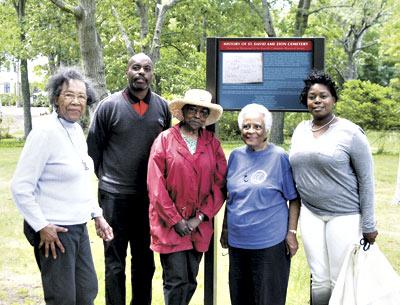Storied Cemetery Studied

June 11 marked an exciting day for the Eastville Community Historical Society, when archaeological students from the University of Minnesota used ground-penetrating radar and mapping techniques to survey the 160-year-old A.M.E. Zion Cemetery. Dedicated to preserving the history of the Eastville area of Sag Harbor for some 30 years, the society has desperately needed money and help to maintain the St. David A.M.E. Zion Church Cemetery.
The church was built in 1839 by African-Americans in the community and the cemetery was founded for members of the congregation in 1857. Eastville itself is one of the earliest known working-class multiethnic communities and in the 1800s was made up of free blacks, European immigrants, and Native Americans. Both African-Americans and Native Americans are buried in the A.M.E. Zion Cemetery.
The historical society was awarded a site preservation grant by the Archaeological Institute of America in 2013. Even so, the grant could not cover all of the cemetery’s expenses, which included a much-needed GIS (geographic information systems) mapping session and a fence to prevent residential encroachment. Luckily for the historical society, Professor Katherine Hayes from the University of Minnesota stepped in to help. This June, the university ran a field school in archaeological survey methods at the Sylvester Manor on Shelter Island, and a portion of the program was devoted to studying and mapping the A.M.E. Zion Cemetery.
Georgette Grier-Key, director of the Eastville Community Historical Society, felt especially thankful to Ms. Hayes and said, “This work would cost $8,000 or more, but because of Kat Hayes, we are getting it done in-kind.” The historical society also has the aid of Emily Kambic Button, a doctoral student at Brown University, and Allison Manfred McGovern, the archaeologist in residence.
According to Chris Brink, a student of archaeology at the University of Minnesota, ground-penetrating radar technology “takes a picture of what is in the soil by sending radar waves into the ground and returning anomalies that exist.” The data collected can then be used, in conjunction with GIS technology, to form a map of what is underneath the soil. This will be particularly useful to the Eastville Community Historical Society, as, without grave markers, it is unsure of how many people are buried in the church cemetery or how far out it extends. The ground-penetrating radar is completely nonintrusive and is therefore ideal for use in cemeteries.
“The aim of the survey,” as Mr. Brink pointed out, “is conservation and preservation, not excavation.”
In conjunction with the archaeological work being done, the Eastville Community Historical Society unveiled the new cemetery sign and hosted a “Sacred Spaces Symposium” on the same day. The new sign, which lists the names of all known people buried in the cemetery and where their graves are located, is a vast improvement on the old, which was wooden and read “A.M.E. Zion Cemetery” in worn letters.
In attendance was Gary Cole, whose great-grandmother Rose Johnson was buried in the A.M.E. Zion Cemetery. Mr. Cole’s grandparents lived in a 1925 house on Hampton Road that the Eastville Community Historical Society now uses as its headquarters. The house was assigned to the society in 1996 by the village of Sag Harbor. Wednesday marked Mr. Cole’s first visit to the house since his childhood, and the first time seeing his family plot in the Eastville cemetery.
Mr. Cole extended his thanks to the historical society and the University of Minnesota by saying, “As a member of the Johnson family I’m here to thank you, and to thank you on behalf of my family.”
Eunice Jackie Vaughan, president of the historical society, also spoke and said, “We’re just so glad that we reached this stage, because this poor cemetery had just been here for so long, and had been forgotten.”
Ms. Grier-Key then spoke about two cemetery upkeep programs that the society is implementing this summer. One, the Stone Cleaning Stewardship program, is designed for children, and will provide them with educational materials on cleaning headstones, as well as the tools to do so. The second is the Adopt a Grave program, which will encourage individuals and businesses to adopt a burial plot for a minimum of $50 and aid in its upkeep. The donations will go to cemetery improvement and hiring necessary contractors. The society is also working on an online database of their collections and the headstones in the cemetery.
After the new sign was unveiled, a “Sacred Spaces Symposium” was held at the Eastville Community Historical Society’s headquarters. The purpose of the symposium was to, as Ms. Grier-Key said, “bring like communities together, like Wantagh, Setauket, and Sag Harbor.” Both Wantagh and Setauket had multiethnic communities comparable to the community in Eastville. Denice Evans-Sheppard of the Long Island Native American Indian alliance, Katherine Hayes, Vivian Nicholson-Mueller, and Maura Doyle gave presentations on their respective fields of historic research.
The Eastville Community Historical Society is very hopeful about the future, and grateful for all of the recent help it has received. Kathleen Tucker, the society’s historian and one of the founding members, was not sure if the day would come when the society would have the money it needed for cemetery upkeep. “I really feel as if everybody who has contributed even a fingertip worth of work has added up to make this possible,” she said.
